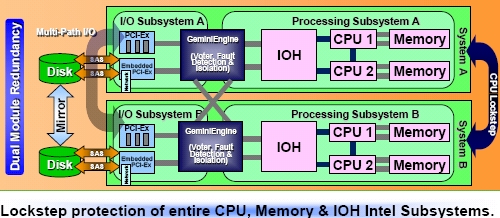This article is more than 1 year old
NEC cranks fault-tolerant servers with Xeon six-shooters
Pitting Hyper-V plus hardware FT against VMware virty FT
Fault-tolerant server maker NEC today rolls out an upgraded FT Series box sporting Intel's "Westmere-EP" Xeon 5600 processors and is also delivering support for Microsoft's Hyper-V server virualization hypervisor, setting the stage for fight between VMware's software-based fault tolerance and the hardware-based fault tolerance and Hyper-V combo.
I know what you are thinking - weren't the Xeon 5600s launched in the middle of March, with lots of machines coming into the field soon thereafter? True. But when you make fault-tolerant servers where you are guaranteeing they will provide a minimum of five nines of availability, at the same time that you are selling a box not only as an application server but now as a virtualized application and database server, you need to do a lot of extra testing and certification.
Mike Mitsch, general manager for the IT Platform Group at NEC America, says that the company could have probably got either the new Express5800/R320b-M4 server using the six-core Xeon 5600 processors or support for Microsoft's Hyper-V server virtualization hypervisor out the door earlier and separately, but the company (like its platform partner, Stratus Technologies, did last week) decided to get the new iron and Hyper-V support out simultaneously.
The Xeon 5000 series processors have special lockstepping functions that NEC and Stratus make use of to create tightly coupled, two-node servers that flip bits in exact synchrony such that if a software error takes out one node, users don't even notice it when they are switched over to the backup node. While this fault tolerance doesn't come cheap--for a given two-socket workload, it costs about five times as much to give it fault tolerance capabilities - the FT setup is considerably less complex than using clustering software and replicating data and applications without lockstepping.
So NEC and Stratus can charge a premium for the GeminiEngine chipset that provides the fault detection and isolation that they add to NEC 5800 series servers to make use of that lockstepping inherent in the processor and turn it into an FT cluster. The GeminiEngine keeps CPU, memory, disk, and network processing in absolute synchronization across the two nodes.

Conceptual diagram of the Express5800 FT servers
However, the FT server market is small enough that they cannot afford to indulge in providing fault tolerance for four-socket or larger x64 servers, although both companies have flirted with the idea in years gone by and even went so far as to have four-socket FT machines based on earlier Xeon MP processors from Intel in their skunkworks. While the Itanium 9100 series processors had core-level lockstepping, which is different from the socket-level lockstepping that NEC and Stratus machines have in their Xeon-based FT machines.
NEC sells both Xeon and Itanium machines and was never tempted to make an Itanium-based FT box using their core-level lockstepping because it is much harder to do than socket-level lockstepping, according to Mitsch. Advanced Micro Devices' Opteron processors do not have the lockstepping circuits that the Xeon 5000 series do, which is why you don't see FT machines built on the Opteron processors.
The Express5800/R320b-M4 does not have a catchy name, but this two-node FT cluster does have Intel's 2.93 GHz, six-core Xeon X5670 processor. By moving to these six-core chips in the R320b-M4, NEC can provide somewhere between 40 and 50 per cent more oomph than the R320a-E4 and R320a-M4 machines that it announced last August, which use the four-core Xeon E5504 (2 GHz) and X5570 (2.93 GHz) processors, respectively. (These were nicknamed the "Nehalem-EP" processors, and these chips gave Intel back the x64 server space and put AMD in the backseat of the market, where is was before the Opteron debut in 2003.)
The new R320b-M4 (and NEC, you really need to get a better naming scheme so dyslexics can tell them apart) has the same 96 GB maximum of main memory, but unlike the other two machines, the memory speed is boosted to 1.33 GHz instead of running at 1.07 GHz.
Moreover, the Westmere-EP box sports 6 GB, 2.5-inch disks in its bays, for a maximum of 4.8 TB, double that of the two smaller (in terms of performance) FT servers in the NEC lineup because these still have 300 GB disks.

The NEC Express 5800 R320b-M4 with its faceplate removed
In a base configuration with a pair of servers with no memory or disk but with on Xeon X5670 processor and a three-year warranty on the iron, NEC is charging $17,000. If you want to add the second processor, cough up another $2,700 each.
That is not the price for a logical computing unit (two physical chips, one each per node in the R320b-M4 machine, but rather a physical processor that has been put through the NEC qualification process for the Xeon X5670s of which you need to add two to double of the processing capacity of the logical machine.
At first glance, this seems a bit pricey compared to Intel list price, which is $1,440 for the same chip, but you have to remember that this NEC price is for a onesie that has had rigorous testing while the Intel price is for a 1,000-unit tray of chips. If you want to buy 1,000 FT servers from NEC, I am certain you can get a decent volume price.
